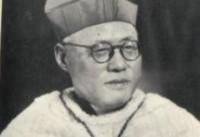A cardinal is the most senior bishop in the Catholic Church. Cardinals are appointed by the Pope and divide the leadership of the various departments of the Holy See and the important parishes of the world. Cardinals also have the right to elect a new Pope and to participate in major meetings convened by the Pope to discuss and decide on major issues of the Church.
Catholicism was introduced into China as early as the Yuan Dynasty. But for centuries, Chinese dioceses were dominated by Westerners. It was not until the mid-20th century that the first Chinese Cardinal, Thomas Tien Ken-sin, was appointed. This was an important step towards the Sinicization of the Catholic church.
Cardinal Thomas Tien Ken-Sin’s given name was Pingsan. He was born in 1890 in Zhangqiu Town, Yanggu County, Shandong Province. His father died when he was young and received the Gospel before he died. Tian had to live with Father Joseph Freinademetz in the Temple of Poli Village, Yanggu County and received his education there. In 1901, at the age of 11, Tien was baptized into the Yanzhou Convent. After that, he studied in a small monastery and later at a much larger monastery in Polli Village, Yanggu. On June 9, 1918, he became a priest in the Church of the Holy Spirit, which was the cathedral for the Bishop of Yanzhou.
Cardinal Thomas Tien Ken-Sin started his missionary work. The dioceses he was part of was located in Juye, Yutai, Wenshang, which had normal economic conditions at that time. Father Tien scrimped and saved to keep the churches running. He often wore shabby clothes and ate only steamed cornbread. He could easily mingle with the locals.
In 1929, Tien Ken-Sin entered the Holy Speech Society where he studied for two years. There he took a vow to become a member of the Society of the Divine Word, which he served all his life. He went to Jiaxiang, Yuncheng, and other areas to do missionary work in 1931. In 1934 (said in 1933), he was appointed by the Holy See as the supervisor of Yanggu Parish in Shandong Province. At that time, there were 12 priests and 13,700 believers in Yanggu parish.
At that time, the first papal representative of the Holy See to China, Celso Costantini, came to China. He broke the resistance of the Patronatus missionum of the French and promoted the sinicization of Catholicism. Although Matteo Ricci, Martino Martini, and other church sages did a lot of good work on the Sinicization of Christianity, the conflict between Chinese and Western ideas and the influence of modern Patronatus missionum of French led to the increasingly tense relationship between Chinese Catholicism and Chinese society and culture. In terms of the church system, the Chinese clergy had been excluded from the episcopal authority for a long time. After coming to China, it was proposed that Chinese clerics could take up positions in the church as long as they were qualified, and there was no problem for them to become bishops. On the recommendation of Celso Costantini, Pope Pius XI personally ordained six Chinese bishops in St. Peter's Basilica in the Vatican on October 28, 1926. This was the first time in more than 200 years since Bishop Gregorio Lopez was ordained.
In 1939, Tien was promoted to be the vicar and head bishop of Yanggu. On November 29, Tien was consecrated as bishop by Pope Pius XII in St. Peter's Basilica. In December 1940, Bishop Tien founded the Sisters of Our Lady of China in Chaocheng County, Yanggu Diocese, which was a rare order founded by Chinese people at that time.
After the establishment of the Sisters of Our Lady, Tien was busy working day and night for the construction of the parish, but he did not forget to go there to teach regularly. In 1942, Tien was appointed bishop of Qingdao Diocese in Shandong Province.
On Christmas Eve 1945, the Pope appointed Tien as the first Cardinal of the Far East. On February 18 the following year, he was confirmed in St. Peter's Basilica. At this time, In order to improve the status of the Chinese Church in the universal Church, Tien advised the Pope to establish a Chinese hierarchy as soon as possible. Soon, it was approved by the Pope. On April 11, the same year, Tien Was appointed by the Pope as the Archbishop of Peiping, and the Chinese Catholic Church established its own hierarchy.
After returning to China, Tien founded the Shanghai Zhi Compilation and Translation Museum, published new books of the Church, and set up the Saint Thomas School of Philosophy at Furen University. On December 4, 1959, the Pope appointed Tien as archbishop of Taipei diocese. On March 1, 1960, Cardinal Tien arrived in Taiwan and took up his post. In Taiwan, he established Joseph convent, Thomas Seminary, and Geng Xin Hospital. He also assisted in the restoration of Furen University and became its President.
On October 11, 1962, the second Vatican Council opened. Tian led the Chinese Bishop team to join the council. On July 24, 1967, Cardinal Tien Ken-Sin, the first Chinese cardinal who devoted his whole life to the Sinicization of Catholicism, passed away at St. Martin's Hospital of the Sisters of Our Lady of China.
- Translated by Nicolas Cao












